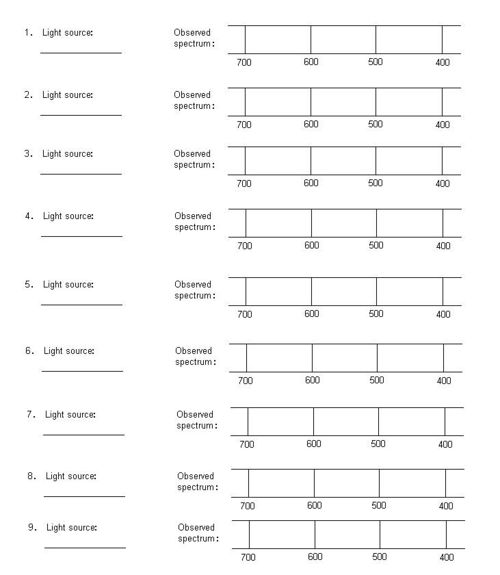Chemistry/Light Spectra Marking Scheme
Maximum = 13
(1) = Proper layout
Purpose : To use a spectroscope to observe the light given off by various light sources and use the spectroscope to analyze an unknown substance.
Method: See handout sheet “Observing the Light Spectrum of Various Light Sources”.
Apparatus: See handout sheet “Observing the Light Spectrum of Various Light Sources”.
(The generally accepted wavelengths of pure colours in the visible region are given in the following table.)
| Colour | Wavelength (nm) | Colour | Wavelength (nm) | Colour | Wavelength (nm) |
|---|---|---|---|---|---|
| violet | 390 – 455 | green | 492 – 577 | orange | 597 – 622 |
| blue | 455 – 492 | yellow | 577 – 597 | red | 622 – 770 |
DISCUSSION
1. What is the most noticeable difference between the spectrum (or spectra) observed in procedure step 2 and any of the spectra observed in procedure step 3?
(1) The spectrum in step 2 is a continuous rainbow of colour (all colours are seen) whereas the spectra in step 3 consists of individual lines.
2. Two common types of spectra are observed; one type is called a “line spectrum” and the other is called a “continuous spectrum”. Based on your observations, explain clearly what you think a “continuous spectrum” is and give an example of such a spectrum. Based on your observations, explain clearly what you think a “line spectrum” is and give an example of such a spectrum.
(1) A continuous spectrum has a continuous set of colours, such as sunlight of a fluorescent light.
(1) A line spectrum consists of several individual lines at various colours, such as the spectrum of lithium.
3.(a) In what way are the spectra of the elements observed in procedure step 3 SIMILAR? That is, what do they all have in common?
(1) All the spectra in step 3 consist of individual lines.
(b) In what way are the spectra of the elements observed in procedure step 3 DIFFERENT?
(1) The lines in the spectra occur at different places and have different colours.
4. (a) How did Bohr explain the presence of lines in the light spectrum of an atom or ion?
(1) Bohr said that electrons exist in different orbits. When the electrons move from a low energy orbit to a higher energy orbit and then back down to the lower energy orbit, the energy given off forms the spectrum of the atom.
(b) In procedure step 3, electricity or heat is used to move electrons from one orbit of an atom or ion to a higher energy orbit. What experimental evidence do you have that the orbits in the different atoms you observed in step 3 have different orbit energies? [Hint: read the Introduction.]
(1) Because the light given off is due to electrons moving between orbits, and because the light from different atoms is different, the energies of the orbits must be different.
5. If an element burns to give a bright yellow light, what colour would you expect the brightest lines to be in the spectrum of the burning element? At what approximate number of nanometers on the spectrometer scale would you expect to see the line(s)?
(1/2) The brightest lines should be in the yellow region.
(1/2) These lines will be in the region 575 to 600 nm.
6. Based on the spectra you observed in procedure step 3, what TWO ions are present in the unknown mixture?
(1) The elements in the mixture are calcium and strontium.
7. Scientists have accurately measured the wavelengths of every line in the spectra of all the known stable elements (some newly–discovered radioactive elements decompose too quickly to enable their spectra to be measured). Suggest how astronomers could use the light coming from distance stars to find the elements present in the stars.
(1) Astronomers can compare the lines in the spectra from stars to the lines of known elements. If the lines from a known element are present in the light from a star, the “known element” is known to be present in the star.
(2) Name: _________________________
